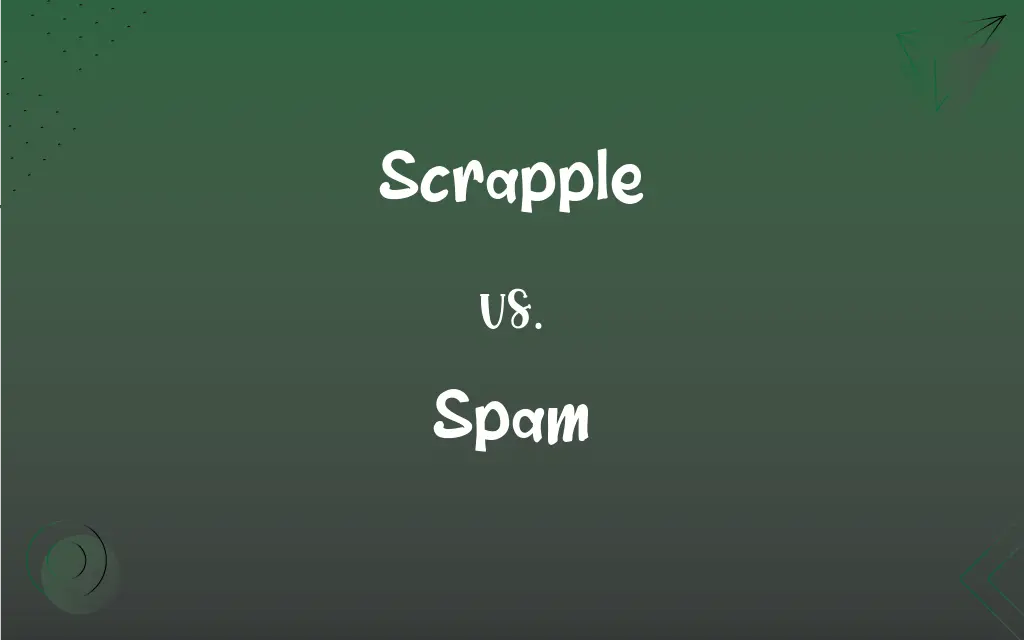Scrapple vs. Spam: What's the Difference?
Edited by Aimie Carlson || By Harlon Moss || Updated on March 4, 2024
Scrapple is a traditional American dish made from pork scraps and trimmings combined with cornmeal and flour, while Spam is a brand of canned cooked pork product known for its versatility and long shelf life.

Key Differences
Scrapple, originating from Pennsylvania Dutch cuisine, is a mush of pork scraps and trimmings, such as the head, heart, liver, and other leftovers, which are boiled to create a broth. Cornmeal and sometimes wheat flour are then added to the broth, along with spices, to form a semi-solid loaf that is sliced and fried before serving. Spam, on the other hand, is a product of Hormel Foods Corporation, created in 1937. It's made from pork shoulder and ham, combined with salt, water, modified potato starch, sugar, and sodium nitrite.
The primary difference between scrapple and Spam lies in their origins, ingredients, and preparation methods. Scrapple is a regional dish with a focus on utilizing all parts of the pig, offering a unique taste and texture from its combination of meats and grains. Spam is a processed meat product known for its distinctive flavor, ease of use, and long shelf life.
While scrapple is traditionally pan-fried, Spam can be eaten straight from the can or cooked in various ways, making it a versatile ingredient in many cuisines.
Comparison Chart
Origin
Pennsylvania Dutch cuisine
Hormel Foods Corporation, United States
Main Ingredients
Pork scraps and trimmings, cornmeal, flour
Pork shoulder, ham, salt, water, sugar, sodium nitrite
ADVERTISEMENT
Preparation
Boiled, formed into a loaf, then sliced and fried
Fully cooked, canned, can be eaten as is or cooked
Texture
Semi-solid, becomes crispy when fried
Soft, uniform texture
Flavor
Varied based on the cuts of pork and spices used
Salty, ham-like flavor
Serving Tradition
Typically served at breakfast with eggs and potatoes
Used in a variety of dishes, from sandwiches to rice dishes
Shelf Life
Requires refrigeration, lasts a few days to a week
Long shelf life, does not require refrigeration until opened
ADVERTISEMENT
Nutritional Value
High in protein, but can be high in fat depending on the pork used
High in protein, fat, and sodium
Cultural Significance
Reflects nose-to-tail eating, minimizing waste
Symbol of American ingenuity, global military, and culinary influence
Scrapple and Spam Definitions
Scrapple
A staple in Pennsylvania Dutch cuisine.
Scrapple is a beloved dish in Amish and Mennonite communities.
Spam
A significant ingredient in many cultures.
Spam is celebrated annually at the Spam Jam Festival in Waikiki.
Scrapple
A traditional breakfast dish made from pork scraps.
He savored a slice of crispy scrapple alongside his morning eggs.
Spam
A canned cooked pork product popular worldwide.
Spam became a staple in Hawaii, used in various local dishes.
Scrapple
Often served pan-fried to achieve a crispy exterior.
She enjoyed her scrapple fried until golden brown.
Spam
Known for its versatility and long shelf life.
Families stocked up on Spam for its convenience and durability.
Scrapple
Symbolizes resourceful use of the whole pig.
Scrapple originated as a way to use up leftover pork parts.
Spam
Became a symbol of American military presence abroad.
Spam's global reach expanded with U.S. military during World War II.
Scrapple
A mush of ground pork and cornmeal that is set in a mold and then sliced and fried.
Spam
Can be eaten straight from the can or cooked.
She made a quick dinner by adding diced Spam to her stir-fry.
Scrapple
A tool for scraping.
Spam
Unsolicited email, often of a commercial nature, sent indiscriminately to multiple mailing lists, individuals, or newsgroups; junk email.
Scrapple
A mush of pork scraps, particularly head parts, and cornmeal or flour, which is boiled and poured into a mold, where the rendered gelatinous broth from cooking jells the mixture into a loaf.
Spam
A single piece of such email
"receiving dozens of spams a day" (George Johnson).
Scrapple
To scrape or grub around.
Spam
To send unsolicited email to.
Scrapple
An article of food made by boiling together bits or scraps of meat, usually pork, and flour or Indian meal.
Spam
To send (a message) indiscriminately to multiple mailing lists, individuals, or newsgroups.
Scrapple
Combines meat with cornmeal and spices.
The unique flavor of scrapple comes from its blend of spices and grains.
Spam
Unsolicited bulk electronic messages.
I get far too much spam.
I received 58 spams yesterday.
Spam
Any undesired electronic content automatically generated for commercial purposes.
Spam
Ellipsis of spam account
Spam
A type of tinned meat made mainly from ham.
Spam
To send spam (i.e. unsolicited electronic messages.)
Spam
To send spam (i.e. unsolicited electronic messages) to a person or entity.
Spam
To do something rapidly and repeatedly.
Stop spamming that special attack!
Spam this button to get a speed boost.
Spam
To post the same text repeatedly with disruptive effect; to flood.
Spam
A canned meat made largely from pork
Spam
Unwanted e-mail (usually of a commercial nature sent out in bulk)
Spam
Send unwanted or junk e-mail
FAQs
What is the historical significance of scrapple?
Scrapple reflects the Pennsylvania Dutch tradition of resourcefulness and efficiency in using all parts of the pig to minimize waste.
How did Spam gain worldwide popularity?
Spam gained worldwide popularity due to its use by the U.S. military during World War II, its convenience, and its role in various cultural cuisines.
Can scrapple and Spam be used interchangeably in recipes?
While both are pork products, their textures and flavors differ, making them not directly interchangeable in recipes without considering these differences.
What role does Spam play in Pacific Islander cuisines?
In Pacific Islander cuisines, particularly in Hawaii, Spam is a beloved ingredient used in a variety of dishes, including Spam musubi and fried rice.
How do cooking methods differ for scrapple and Spam?
Scrapple is typically sliced and pan-fried until crispy, while Spam can be eaten as is, fried, baked, or added to other dishes.
Can scrapple or Spam be considered healthy?
Both can be part of a balanced diet in moderation, but due to their high sodium and fat content, they might not be the best choice for those with specific dietary restrictions or health concerns.
How has the perception of Spam and scrapple changed over time?
Both have seen fluctuating perceptions, from wartime necessities to cultural staples, and in some cases, have been reembraced for their unique roles in regional and global cuisines.
Are there vegetarian or vegan alternatives to scrapple and Spam?
Yes, there are vegetarian and vegan versions of both, using plant-based ingredients to mimic the texture and flavor of the originals.
What are some creative ways to use Spam or scrapple in cooking?
Creative uses include incorporating scrapple into stuffing or casseroles and using Spam in sushi, sliders, or as a pizza topping.
What is the cultural impact of scrapple and Spam in their regions of origin?
Scrapple remains a symbol of Pennsylvania Dutch heritage, while Spam's cultural impact includes its historical military use and its adoption into various international cuisines, showcasing American influence and culinary adaptability.
What are the nutritional concerns associated with Spam and scrapple?
Both can be high in sodium and fat, which may be a concern for those monitoring their intake for health reasons.
How do non-meat eaters view scrapple and Spam?
Non-meat eaters may view both products skeptically due to their animal product content, but there are plant-based alternatives that mimic the texture and flavor for those interested in trying these dishes.
What innovations or variations have been introduced for scrapple and Spam?
Innovations include various flavors of Spam introduced by Hormel to appeal to different tastes and culinary traditions, and for scrapple, recipes that incorporate new spices or ingredients for a modern twist on the traditional dish.
Is there a preferred season or occasion for consuming scrapple or Spam?
Scrapple is often enjoyed in the colder months as a hearty breakfast food, while Spam is consumed year-round, with no specific season or occasion due to its convenience and versatility.
What is the best way to store scrapple and Spam?
Scrapple should be refrigerated and consumed within a few days to a week, while unopened cans of Spam can be stored in a pantry and have a long shelf life. Once opened, Spam should be refrigerated and consumed within a few days.
How do the flavors of scrapple and Spam compare?
Scrapple has a more complex flavor profile that varies based on the spices used and the types of pork scraps included, whereas Spam has a consistent salty, ham-like flavor.
How have scrapple and Spam influenced fast food or restaurant menus?
Both have found their way onto restaurant menus, with scrapple appearing in traditional breakfast spots and diners, and Spam featured in various fast food and casual dining establishments, especially in regions where it's particularly popular.
How do preparation times compare between scrapple and Spam?
Both are relatively quick to prepare, with scrapple requiring slicing and pan-frying, and Spam being even faster if eaten straight from the can or quickly fried.
What are the environmental impacts of producing Spam and scrapple?
The production of Spam and scrapple involves meat processing, which has environmental impacts related to animal farming, including resource use and greenhouse gas emissions. However, scrapple's use of leftover parts aligns with sustainable practices by reducing waste.
What is the global availability of Spam and scrapple?
Spam is available worldwide, given its global brand recognition and distribution. Scrapple is more regionally focused, primarily found in the Mid-Atlantic United States, though it can be sourced in specialty stores or online.
About Author
Written by
Harlon MossHarlon is a seasoned quality moderator and accomplished content writer for Difference Wiki. An alumnus of the prestigious University of California, he earned his degree in Computer Science. Leveraging his academic background, Harlon brings a meticulous and informed perspective to his work, ensuring content accuracy and excellence.
Edited by
Aimie CarlsonAimie Carlson, holding a master's degree in English literature, is a fervent English language enthusiast. She lends her writing talents to Difference Wiki, a prominent website that specializes in comparisons, offering readers insightful analyses that both captivate and inform.
































































